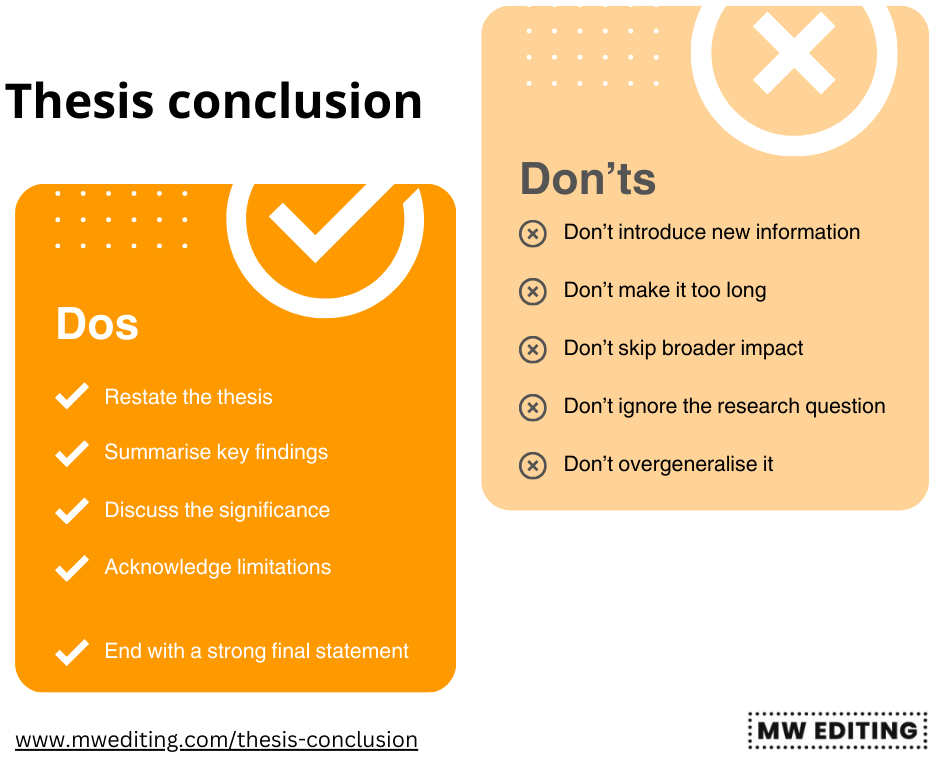A thesis conclusion is the final section of a thesis, which accounts for 5–7% of the entire word count. This section summarises findings, answers the research question, highlights the significance of the work, acknowledges the limitations and provides the recommendations for future research. It ties together the entire thesis and leaves a lasting impression on the reader.
- Function of a thesis conclusion
- Elements of a thesis conclusion
- Sample of a thesis conclusion (education)
- Sample of a thesis conclusion (environmental studies)
- Tips for writing an effective thesis conclusion
- Resources for writing an effective thesis conclusion
- Finalising a thesis conclusion with editing services
What is the function of a thesis conclusion?
The thesis conclusion is important because it serves several key purposes:
- Summarises key findings: It concisely summarises the research findings, highlighting the main points discussed in the thesis.
- Answers the research question: It explicitly addresses the research question or hypothesis, confirming whether the objectives were met.
- Provides final insights: It offers final reflections on the research, including its significance, implications and potential for future study.
- Strengthens the argument: By reiterating the importance of the research and its contributions, the conclusion reinforces the thesis argument.
- Leaves a lasting impression: It leaves a strong impression on the reader, ensuring that the research is remembered and valued.
What are the elements of a thesis conclusion?
A strong thesis conclusion typically includes the following key elements:
- Restatement of the thesis statement: A concise rephrasing of the main argument or research question, reflecting how it has been addressed in the thesis.
- Summary of key findings: A brief recap of the most important results or insights gained from the research. This section should highlight how these findings support the thesis statement.
- Discussion of the research significance: An explanation of the importance of the research, including its contributions to the field, practical implications or theoretical advancements.
- Consideration of limitations: Acknowledge any limitations in the research, demonstrating a critical and honest approach. This might include discussing the scope, methodology or data constraints.
- Recommendations for future research: Suggest areas where further research is needed or could build upon the findings of the thesis.
- Final thoughts or concluding remarks: A strong closing statement that leaves a lasting impression, possibly by reflecting on the broader implications of the research or offering a call to action.
Sample research conclusion 1 — education
Restatement of the thesis statement: This study has shown that integrating technology in primary education enhances student engagement and improves learning outcomes.
Summary of key findings: The research revealed that classrooms using interactive digital tools saw a 15% increase in student participation and higher test scores in literacy and numeracy.
Discussion of the research’s significance: These results demonstrate the value of technology as a catalyst for educational improvement, offering evidence for its broader implementation in curricula.
Consideration of limitations: The study was constrained by the short duration of the intervention and the limited sample size, which may affect the generalisability of the findings.
Recommendations for future research: Further research should investigate the long-term effects of technology integration in diverse educational settings and its impact on different age groups.
Final thoughts or concluding remarks: This research supports the ongoing evolution of teaching methods, encouraging educators to embrace technological advancements to foster more dynamic and effective learning environments.
Sample research conclusion 2 — Environmental studies
Restatement of the thesis statement: This research has shown that urban green spaces are crucial in mitigating the urban heat island effect and improving air quality in densely populated areas.
Summary of key findings: The study found that cities with more than 20% green space coverage had surface temperatures up to 3°C lower than those with less than 10% coverage, along with a 15% reduction in particulate matter concentration.
Discussion of the research’s significance: These findings highlight the importance of integrating green spaces into urban planning as a cost-effective strategy for climate adaptation and public health improvement.
Consideration of limitations: The research was limited by the availability of consistent data across different cities and the relatively short time frame of environmental monitoring.
Recommendations for future research: Future studies should explore the long-term impact of green spaces on urban microclimates and investigate their potential in cities facing rapid urbanisation.
Final thoughts or concluding remarks: Overall, this research underscores the vital role of green spaces in sustainable urban development and calls for policymakers to prioritise their preservation and expansion.

Tips for writing an effective thesis conclusion
Here are revised tips for writing an effective thesis conclusion:
- Start early: Begin thinking about your conclusion while writing other sections to ensure consistency and coherence.
- Synthesise, don’t summarise: Instead of merely summarising, weave together your findings to show how they collectively support your thesis.
- Avoid repetition: Don’t repeat content verbatim from earlier sections; instead, rephrase and integrate ideas to provide a fresh perspective.
- Keep it proportionate: Make sure the conclusion is concise and typically no more than 5–7% of the total word count.
- Reflect on broader implications: Consider the wider impact of your research beyond the immediate findings, connecting it to broader debates or societal issues.
- Maintain a confident tone: Write with confidence, reflecting the importance and validity of your research, but avoid overstating your conclusions.
Resources for writing an effective thesis conclusion
- Academic Phrasebank by the University of Manchester provides phrases and sentence structures that can be used in writing thesis conclusions.
- How to Write a Thesis by Umberto Eco offers advice on every aspect of thesis writing, including how to conclude your research.
- Purdue Online Writing Lab offers detailed guidance on writing conclusions, with examples and tips for academic writing.
- The Craft of Research by Wayne C. Booth, Gregory G. Colomb and Joseph M. Williams explains conducting research and writing academic papers, including advice on crafting conclusions.
- Writing the Winning Thesis or Dissertation: A Step-by-Step Guide by Randy L. Joyner, William A. Rouse and Allan A. Glatthorn provides practical tips and strategies for writing all parts of a thesis, focusing on successfully concluding your work.
- Open Access Theses and Dissertations contains thousands of completed dissertations and theses. There, you can find examples of conclusions that have already been reviewed.
How can editing services help finalise a thesis dissertation?
Editing services — copyediting and proofreading — are crucial in finalising a thesis conclusion by ensuring clarity, accuracy and professionalism.
Copyediting
- Clarity and coherence: Copyediting helps improve the clarity and flow of the conclusion. The editor can ensure that ideas are logically connected, sentences are well-structured, and the argument is presented coherently.
- Consistency: Copyeditors check for consistency in terminology, tone and style throughout the conclusion. This is especially important to maintain a professional and uniform voice in academic writing.
- Precision: Copyediting ensures that language is precise and appropriate for the academic context. This includes refining complex sentences, removing jargon and ensuring that the language is concise without sacrificing meaning.
- Accuracy: A copyeditor can verify correct use of citations and references terms, aligning with the chosen style guide (e.g. APA, MLA, Chicago).
- Grammar and syntax: Copyediting focuses on correcting grammatical errors, punctuation mistakes and syntax issues that could distract the reader or undermine the credibility of the conclusion.
Proofreading
- Spelling and typographical errors: Proofreaders meticulously check for and correct any spelling mistakes or typos. This work ensures the conclusion is polished and error-free.
- Formatting consistency: Proofreaders ensure that the formatting of the conclusion (e.g. headings, font size, spacing) is consistent with the rest of the thesis and meets the submission guidelines.
- Final polish: Proofreading gives the thesis conclusion a final polish, ensuring it presents professionally and ready for submission. This final step is crucial for leaving a strong impression on the reader.
Final takeaways
In conclusion, a thesis conclusion is vital. It ties together findings, answers the research question and highlights significance. To create a strong conclusion, restate the thesis, summarise key findings, discuss significance and acknowledge limitations. Use effective writing strategies and resources, along with editing services, to ensure clarity and impact. This final section leaves a lasting impression, highlighting the research’s value and paving the way for future studies.
If you are an academic author looking to publish your work and need editing services, contact me. I am an experienced editor working, and I offer a free sample edit and an early bird discount.

